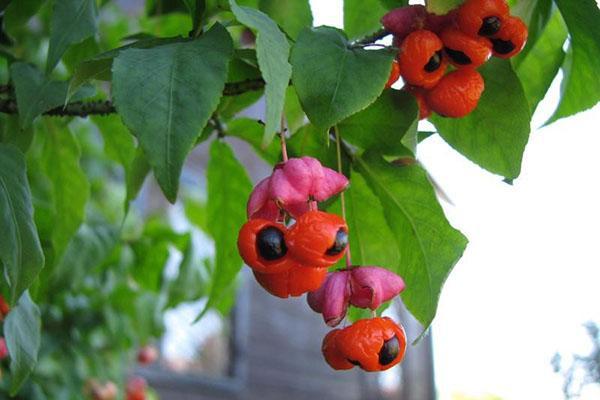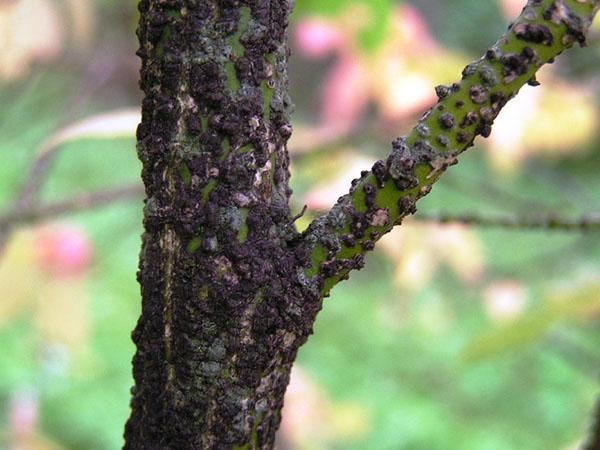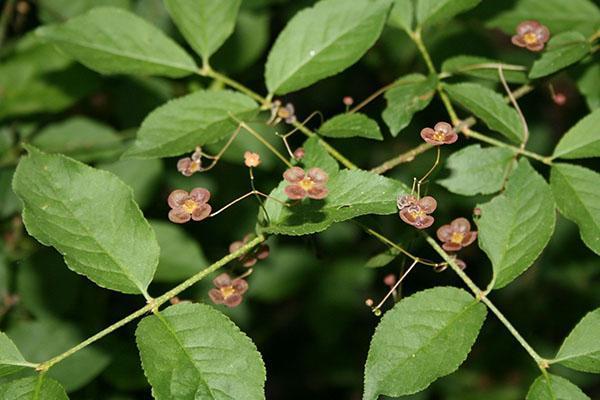Handsome man from the neighboring forest warty euonymus
 In the old days it was believed that the euonymus near the outskirts would drive away evil spirits and would certainly attract peace and prosperity to the house. It is impossible to check the veracity of grandmother's legends, but one glance at the warty euonymus is enough to get closer and see an unusually bright shrub for the middle lane.
In the old days it was believed that the euonymus near the outskirts would drive away evil spirits and would certainly attract peace and prosperity to the house. It is impossible to check the veracity of grandmother's legends, but one glance at the warty euonymus is enough to get closer and see an unusually bright shrub for the middle lane.
The area where this species of spindle tree is found everywhere is extremely extensive. In Russia, the culture grows in light coniferous and deciduous forests, in oak forests, on clearings that are beginning to overgrow and along the edges. The distribution area extends from Narva to Krasnodar, from Pskov to Perm. In Europe, the warty euonymus, in the photo, can be found from the south of Sweden to the countries of the Balkan Peninsula.
It is not surprising that the plant was noticed by lovers of ornamental crops, and in the second half of the 18th century it appeared among plantings in park ensembles in Moscow, St. Petersburg and other regions of the country.
Today, deciduous shrubs, showing enviable frost resistance and unpretentiousness, have become common outside their natural range, for example, in Altai and the Urals, in Primorye and the states of Central Asia.
Read about European euonymus!
Description of warty euonymus

Spindle trees are slow growing plants. The warty variety is no exception.
The most intensive growth occurs in the first 15 years from the moment of seed germination. Over the years, the shrub reaches one and a half meters in height. In subsequent years, the growth is extremely small, and after the age of 30, all efforts of the euonymus are aimed at replacing old shoots and maintaining the crown. Typically, the age limit for this culture is 50 years.
Young shoots are distinguished by a greenish-brown tint, but over time the bark darkens, becoming almost black, cracks and takes on some kind of unreal appearance.
Euonymus verrucosus is the specific name of the verrucous euonymus fully reflects the plant's belonging to the vast family of euonymus, and its external feature, by which it is easy to recognize that of the Russian forest and forest-steppe zones, as well as other regions of Eurasia. Large and small shoots of the plant are covered with peculiar cork growths, similar to warts or, as this word sounds in Latin, verruca. It is they who provide the recognition of the warty euonymus shown in the photo.
 From mid-May to June, the branches of the bush are covered with numerous flowers. True, unlike other ornamental plants, they are completely unattractive near the euonymus. Corollas of a brownish tint in diameter do not exceed a centimeter, consist of:
From mid-May to June, the branches of the bush are covered with numerous flowers. True, unlike other ornamental plants, they are completely unattractive near the euonymus. Corollas of a brownish tint in diameter do not exceed a centimeter, consist of:
- of four rounded petals;
- from the calyx connecting the flower with the peduncle;
- from a pistil and four tiny stamens.
Individual flowers are combined into small loose inflorescences of 4-9 pieces each. Flowering is accompanied by an unpleasant odor, which is sometimes called "mouse". This interesting feature of the warty euonymus is due to the fact that some species of flies are the pollinators of the plant.Insects are attracted by the specific aroma and mucus produced by flowers and becoming a delicacy for the inhabitants of the forest.
 Euonymus shoots are covered with elongated ovate, serrated leaves located opposite each other. The length of the sheet can vary from one and a half to six centimeters. In summer, the color of the foliage pointed at the end on the outside is dark green, even. The back side of the leaf plate is lighter than the top, while it is sometimes covered with barely noticeable pile. With the onset of autumn, the color of the crown changes radically. As in the photo, the leaves of the warty euonymus turn pink, purple, or burgundy-red.
Euonymus shoots are covered with elongated ovate, serrated leaves located opposite each other. The length of the sheet can vary from one and a half to six centimeters. In summer, the color of the foliage pointed at the end on the outside is dark green, even. The back side of the leaf plate is lighter than the top, while it is sometimes covered with barely noticeable pile. With the onset of autumn, the color of the crown changes radically. As in the photo, the leaves of the warty euonymus turn pink, purple, or burgundy-red.
Ripe fruits complement the amazing picture created by the euonymus. Beginning in August, the 4-nested pods take on a bright pink or reddish carmine color. Then they open up to give birth to shiny black seeds, covered with dense orange seedlings.
 The fruits are small, their diameter reaches 8–12 mm, the seeds are even smaller and do not exceed 6–7 mm. The boxes hanging on thin stalks were presented to the warty euonymus, in the photo, several more names, including "wolf earrings".
The fruits are small, their diameter reaches 8–12 mm, the seeds are even smaller and do not exceed 6–7 mm. The boxes hanging on thin stalks were presented to the warty euonymus, in the photo, several more names, including "wolf earrings".
Since the flowering of the culture lasts about three weeks, the seed ripening is also uneven. The appearance of bright fruit trees attracts many birds, willingly pecking them together with a juicy breeder and carrying seeds for many kilometers. And the seeds remaining on the bush fall off within 7-10 days after the opening of the capsules.
It is interesting that passing through the digestive tract increases the germination of seeds, but still, in nature, this culture often propagates vegetatively with the help of root or stem layers.
The use of warty euonymus in landscape design: photos and tips
 The root system of the warty spindle tree has a superficial location, and the depth of the roots is largely dependent on the soil, climatic and landscape conditions in which the plant is located. To provide itself with a reliable attachment to the ground, the euonymus acquires an extensive system of large and small rhizomes, which at the same time strengthen the soil layer in the place where the culture grows. This feature of the euonymus in landscape design, as in the photo, is actively used when landscaping and strengthening is necessary;
The root system of the warty spindle tree has a superficial location, and the depth of the roots is largely dependent on the soil, climatic and landscape conditions in which the plant is located. To provide itself with a reliable attachment to the ground, the euonymus acquires an extensive system of large and small rhizomes, which at the same time strengthen the soil layer in the place where the culture grows. This feature of the euonymus in landscape design, as in the photo, is actively used when landscaping and strengthening is necessary;
- steep man-made slopes;
- ravines where there is a risk of wind erosion;
- steep banks of artificial and natural reservoirs.
 Plants, accustomed to being under the canopy of a forest, easily tolerate a lack of light, are not afraid of hot days, when the air loses moisture with vapor. But for the warty euonymus grown on the site, it is important to ensure the presence of nutritious, well-drained soil and regular watering.
Plants, accustomed to being under the canopy of a forest, easily tolerate a lack of light, are not afraid of hot days, when the air loses moisture with vapor. But for the warty euonymus grown on the site, it is important to ensure the presence of nutritious, well-drained soil and regular watering.
 When using euonymus in landscape design, as in the photo, one more cultural feature must be taken into account. The density of the crown, its compactness and the amount of foliage on the shoots are directly proportional to the lighting. Specimens grown in open places are more decorative and bright than those that were hidden under the crowns of broad-leaved trees for many years.
When using euonymus in landscape design, as in the photo, one more cultural feature must be taken into account. The density of the crown, its compactness and the amount of foliage on the shoots are directly proportional to the lighting. Specimens grown in open places are more decorative and bright than those that were hidden under the crowns of broad-leaved trees for many years.
In the first case, euonymus is easier to form, shoots thicken, internodes are shortened, and the number of lateral shoots, flowers and ovaries increases.
 In plants grown in the shade, shoots do not form a strong bark for a long time, remaining thin and greenish. The branches are elongated, there are few leaves on the euonymus, as in the photo. The crown is sparse and unattractive.
In plants grown in the shade, shoots do not form a strong bark for a long time, remaining thin and greenish. The branches are elongated, there are few leaves on the euonymus, as in the photo. The crown is sparse and unattractive.
Correcting the situation with pruning will not work due to the very slow growth of the plant.
It is more correct to initially plant euonymus where the culture will be in the sun for at least half a day. This rule is also taken into account in the case of using warty euonymus in group plantings with larger plants.
Use of warty spindle tree: the benefits and risks of the plant
 Since ancient times, euonymus has attracted human attention not only for the beauty of its leaves and fruits, but also for its useful qualities. In the West, this deciduous shrub is called nothing more than "spindle". The reason for this nickname is quite prosaic. Since the Middle Ages, peasants have carved spindles for spinning wool from light, durable euonymus wood.
Since ancient times, euonymus has attracted human attention not only for the beauty of its leaves and fruits, but also for its useful qualities. In the West, this deciduous shrub is called nothing more than "spindle". The reason for this nickname is quite prosaic. Since the Middle Ages, peasants have carved spindles for spinning wool from light, durable euonymus wood.
And already at the beginning of the last century, gutta was discovered in the thickness of the euonymus bark - a rubber-like substance from which electrical insulating materials, parts of devices for the chemical industry, consumables for the footwear industry and medicine were made before the discovery of synthetic plastics. Today the need for this substance has disappeared, but scientists decided to carefully consider the chemical composition of not only the bark, but also other parts of the plant.
As a result, euonymus has found application in homeopathy and in official medicine as a heart, laxative and emetic. But it is worth remembering that decorating a garden, this culture can be potentially dangerous to people and pets.
Found in bright fruits, roots, branches and leaves of euonymus, in the photo, glycosides have a therapeutic effect only in extremely small doses and only in the composition of medicines.
Eaten bright fruits and other parts of the plant lead to poisoning, accompanied by dizziness, weakness, diarrhea and vomiting, and in severe cases - chills, convulsions, heart problems. At the slightest suspicion of the ingestion of fruits or greenery of the euonymus, it is important to seek qualified medical help as soon as possible.